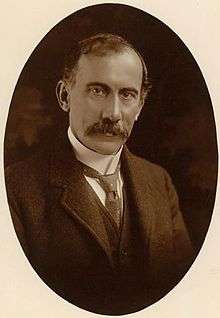William Higgs
| The Honourable William Higgs | |
|---|---|
 | |
| Senator for Queensland | |
|
In office 30 March 1901 – 31 December 1906 | |
| Member of the Australian Parliament for Capricornia | |
|
In office 13 April 1910 – 16 December 1922 | |
| Preceded by | Edward Archer |
| Succeeded by | Frank Forde |
| Member of the Queensland Legislative Assembly for Fortitude Valley | |
|
In office 11 March 1899 – 17 July 1901 Serving with Frank McDonnell | |
| Preceded by | John McMaster |
| Succeeded by | John McMaster |
| Personal details | |
| Born |
18 January 1862 Wingham, New South Wales |
| Died |
11 June 1951 (aged 89) Melbourne, Victoria |
| Nationality | Australian |
| Political party | Labor (1901–20) |
| Other political affiliations |
Independent (1920) Nationalist (1920–22) |
| Spouse(s) | Mary Ann Knight |
| Profession | Printer, Editor |
| Religion | Church of England, Christian Science |
William Guy Higgs (18 January 1862 – 11 June 1951) was an Australian politician.
William Higgs was born on 18 January 1862 at Wingham, New South Wales, the son of a Cornish storekeeper, William Guy Higgs.
Higgs' political career began first by being elected to the North Ward of the Brisbane City Council in February 1899 and then winning the electorate of Fortitude Valley in the Parliament of Queensland later in the same year.[1]

After Federation of the Australian states, he became a Senator for Queensland from 30 March 1901 until 31 December 1906.[1]
He was elected to the House of Representatives at the 1910 general election as the member for Capricornia,[3] Queensland. He was the first former Senator to be elected to the House of Representatives, and the first Queenslander to have served in both houses of federal parliament.
He served as Treasurer in the ministry of Billy Hughes from 1915 to 1916, until he resigned due to his opposition to Hughes' support for conscription during World War I. Hughes and the other pro-conscriptionists were expelled from the party soon afterward. However, Higgs was somewhat troubled by the expulsion of many of his old friends. He was also concerned that Labor was taking an increasingly radical turn. Despite this, he remained with Labor, even becoming deputy leader in 1918. However, in 1919, when Labor opposed Hughes' plans to increase the federal government's powers over industry and commerce, Higgs supported them and was expelled from the party in January 1920. After eight months as an independent, he joined Hughes' Nationalist Party.[1] However, Capricornia was naturally a Labor seat, and at the 1922 election, he was soundly defeated by Labor's Frank Forde.[4]
Life after politics
Higgs later became a campaigner for the plight of the mentally ill and was the Honorary president of the Society for the Welfare of Mental Patients.[1] He wrote books on the subject; petitioned the Government of Victoria to improve conditions in Victorian Mental Hospitals and proposed changes to the Victorian Lunacy Act.[5]
References
- 1 2 3 4 Higgs, William Guy (1862 - 1951), — Australian Dictionary of Biography
- ↑ History of the Australian Labor Party The spelling of "Labor" in "Australian Labor Party" was not adopted by the party until 1912.
- ↑ Federal Legislative Election of 13 April 1910 (Qld results), — Psephos: Adam Carr's Electoral Archive
- ↑ Federal Legislative Election of 16 December 1922 (Qld results), — Psephos: Adam Carr's Electoral Archive
- ↑ Higgs, W. G. (1931) A Plea for Better Treatment of the Mentally Afflicted: What can happen to a man. (2nd ed). Society for the Welfare of the Mentally Afflicted, Kew.
| Political offices | ||
|---|---|---|
| Preceded by Andrew Fisher |
Treasurer of Australia 1915–1916 |
Succeeded by Alexander Poynton |
| Parliament of Australia | ||
| Preceded by Edward Archer |
Member for Capricornia 1910–1922 |
Succeeded by Frank Forde |
| Parliament of Queensland | ||
| Preceded by John McMaster |
Fortitude Valley 1899 - 1901 Served alongside: Frank McDonnell |
Succeeded by John McMaster |